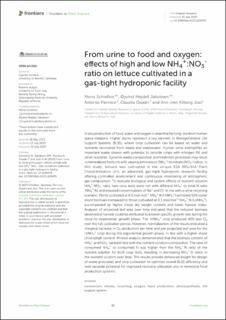| dc.contributor.author | Schiefloe, Mona | |
| dc.contributor.author | Jakobsen, Øyvind Mejdell | |
| dc.contributor.author | Pannico, Antonio | |
| dc.contributor.author | Quadri, Claudia | |
| dc.contributor.author | Kittang, Ann-Iren | |
| dc.date.accessioned | 2024-02-13T13:42:46Z | |
| dc.date.available | 2024-02-13T13:42:46Z | |
| dc.date.created | 2023-09-04T10:12:20Z | |
| dc.date.issued | 2023 | |
| dc.identifier.citation | Frontiers in Plant Science. 2023, 14 . | |
| dc.identifier.issn | 1664-462X | |
| dc.identifier.uri | https://hdl.handle.net/11250/3117341 | |
| dc.description.abstract | In situ production of food, water and oxygen is essential for long-duration human space missions. Higher plants represent a key element in Bioregenerative Life Support Systems (BLSS), where crop cultivation can be based on water and nutrients recovered from waste and wastewater. Human urine exemplifies an important waste stream with potential to provide crops with nitrogen (N) and other nutrients. Dynamic waste composition and treatment processes may result in mineralized fractions with varying ammonium (NH4+) to nitrate (NO3-) ratios. In this study, lettuce was cultivated in the unique ESA MELiSSA Plant Characterization Unit, an advanced, gas-tight hydroponic research facility offering controlled environment and continuous monitoring of atmospheric gas composition. To evaluate biological and system effects of nutrient solution NH4+:NO3- ratio, two crop tests were run with different NH4+ to total N ratio (NH4+:N) and elevated concentrations of Na+ and Cl- in line with a urine recycling scenario. Plants cultivated at 0.5 mol·mol-1 NH4+:N (HiNH4+) achieved 50% lower shoot biomass compared to those cultivated at 0.1 mol·mol-1 NH4+:N (LoNH4+), accompanied by higher shoot dry weight content and lower harvest index. Analyses of projected leaf area over time indicated that the reduced biomass observed at harvest could be attributed to a lower specific growth rate during the close-to-exponential growth phase. The HiNH4+ crop produced 40% less O2 over the full cultivation period. However, normalization of the results indicated a marginal increase in O2 production per time and per projected leaf area for the HiNH4+ crop during the exponential growth phase, in line with a higher shoot chlorophyll content. Mineral analysis demonstrated that the biomass content of NH4+ and NO3- varied in line with the nutrient solution composition. The ratio of consumed NH4+ to consumed N was higher than the NH4+:N ratio of the nutrient solution for both crop tests, resulting in decreasing NH4+:N ratios in the nutrient solution over time. The results provide enhanced insight for design of waste processes and crop cultivation to optimize overall BLSS efficiency and hold valuable potential for improved resource utilization also in terrestrial food production systems. | |
| dc.description.abstract | From urine to food and oxygen: effects of high and low NH4+:NO3- ratio on lettuce cultivated in a gas-tight hydroponic facility | |
| dc.language.iso | eng | |
| dc.rights | CC BY 4.0 | |
| dc.rights.uri | https://creativecommons.org/licenses/by/4.0/deed.no | |
| dc.title | From urine to food and oxygen: effects of high and low NH4+:NO3- ratio on lettuce cultivated in a gas-tight hydroponic facility | |
| dc.title.alternative | From urine to food and oxygen: effects of high and low NH4+:NO3- ratio on lettuce cultivated in a gas-tight hydroponic facility | |
| dc.type | Peer reviewed | |
| dc.type | Journal article | |
| dc.description.version | publishedVersion | |
| dc.source.pagenumber | 0 | |
| dc.source.volume | 14 | |
| dc.source.journal | Frontiers in Plant Science | |
| dc.identifier.doi | 10.3389/fpls.2023.1229476 | |
| dc.identifier.cristin | 2171990 | |
| cristin.ispublished | true | |
| cristin.fulltext | original | |
| cristin.fulltext | | |
| cristin.qualitycode | 2 | |

